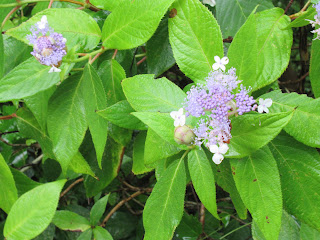Hydrangea macrophylla is Japanese endemic species. The original species is lacecap hydrangea we can easily find in Kanagawa’s coast area. There are several theories how the Japanese lacecap flower was introduced to European Court Society. Though, the established story is it was during the 17th century. From the Society the flower spread world-wide and received numerous selective breeding. Now the garden variety would have more than 2000 kinds and decorating our garden.
 |
| Lacecap
hydrangea is casually decorating a strolling path in Hayama Town. |
In more mountainous area of Kanagawa, we have also the other kinds of wild hydrangea, like
 |
| Hydrangea involucrata Siebold, in Tanzawa. |
 |
| Hydrangea serrata, aka Tea of Heaven, in Hakone. |
 |
| Hydrangea hirta, in Hakone. |
They are also very attractive. Japan has seasonal rainy season between spring and summer. During these wet days, hydrangea is THE flower occupying the center stage of our psyche. In suburbs Yokohama, we can find many varieties here and there in our neighborhood gardens. Like
It’s strange. This hydrangea has almost sepals only, i.e. it is a heavily modified variety. Having an attractive smell for sterile parts does not make sense, don’t you think? I guess its faint scent is the result of human intervention … it’s a successful breeding for sure. Later I noticed its smell is the aroma we are surrounded by in a park when it is raining for a June day. A-ha. It’s a calming smell. Quiet park, rain, and slight scent wafting unconsciously into our psych …
The wind, one brilliant day, called
to my soul with an odor of jasmine.
'In return for the odor of my jasmine,
I'd like all the odor of your roses.'
'I have no roses; all the flowers
in my garden are dead.'
'Well then, I'll take the withered petals
and the yellow leaves and the waters of the fountain.'
the wind left. And I wept. And I said to myself:
'What have you done with the garden that was entrusted to you?'
657 Nanasawa, Atsugi City, 243-0121
〒243-0121 厚木市七沢657
Phone: 046-248-0323
You can send an enquiry to them by clicking the bottom line of their homepage at http://www.pref.kanagawa.jp/div/1644/








No comments:
Post a Comment